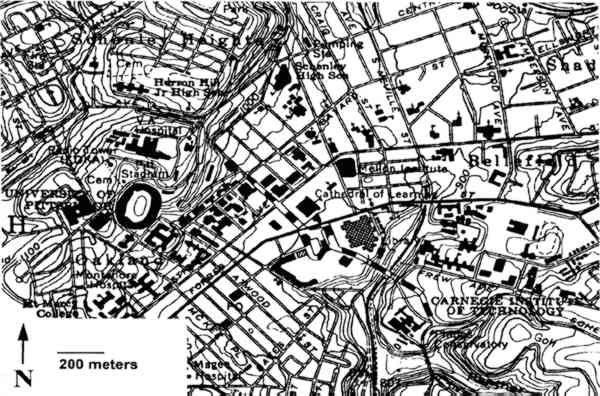VERTICAL GRADIENTS OF POLLUTANT CONCENTRATIONS AND DEPOSITION FLUXES ON A TALL LIMESTONE BUILDINGVICKEN ETYMEZIAN, CLIFF I. DAVIDSON, SUSAN FINGER, MARY F. STRIEGEL, NOEMI BARABAS, & JUDITH C. CHOW
1 INTRODUCTIONSeveral types of building stone deterioration have been well documented, including discoloration, erosion of material, and changes in the physical and chemical characteristics of the surface. Developing strategies to prevent this deterioration requires knowledge of the processes by which the damage occurs—for example, by deposition of air pollutants or by biological growth on the stone surface. Furthermore, the choice of cleaning and restoration techniques depends on the processes causing the damage. Differentiating between pollutant deposition and biological growth is difficult and generally requires on-site testing. Unfortunately, getting access to the building walls sometimes demands scaffolding, and due to expense scaffolds are typically not erected until shortly before restoration work begins. Thus, early identification of the primary deteriorating or discoloring agents is often difficult and tentative. In this study, field measurements of air pollutant concentrations and deposition are used in conjunction with archival photographs to draw conclusions regarding the role of pollutants in the soiling of a tall building. The structure of interest is the 42-story Cathedral of Learning, a National Historic Landmark on the University of Pittsburgh campus (fig. 1). The building is made of Indiana limestone and was constructed between 1929 and 1937. Since the time of construction, there have been numerous air pollution sources within a few kilometers of the building. These include steel manufacturing plants that employ coke ovens and blast furnaces, a coal-burning steam plant, heavy motor vehicle traffic, coal-burning railroads and riverboats, and a large number of domestic coal combustion sources such as home furnaces.
At present, two sides of the Cathedral of Learning have extensive soiling, particularly on the lower two-thirds of the building. In a study on the alteration crust at the cathedral, McGee (1995, 1997) and Etyemezian et al. (1998b) report that iron-, silicon-, and aluminum-rich fly ash particles are found in samples of soiled surfaces and that such particles are much less prevalent in samples of unsoiled surfaces. This result indicates that surface soiling at the cathedral is primarily due to the deposit of anthropogenic particles to the building walls. This research had three major objectives. First, we wanted to identify the extent to which airborne concentrations of certain pollutants vary with height on the cathedral. The pollutants of interest include SO42− particles, carbon particles, sulfur dioxide gas (SO2), total NO3− (HNO3 gas and NO3− particles), and total particle number. Such information can provide insight into the relative importance of local and regional sources of pollutants as well as pathways for delivery of pollutants to the building surface. Second, we wished to examine variations in dry deposition of SO2 with height and location. This information can provide insight into whether the variability in pollutant deposition is partly responsible for the observed soiling patterns. Third, we wished to consider long-term variations in soiling patterns on the building in light of changes in pollution concentrations. This part of the project made use of previously obtained historical pollutant data as well as archival photographs. Such information enabled us to investigate the roles of pollutant deposition and subsequent wash-off by rain in affecting the soiling. Although this study focused on only one building, the results may also be applicable to similarly structured buildings in similar environments. |
